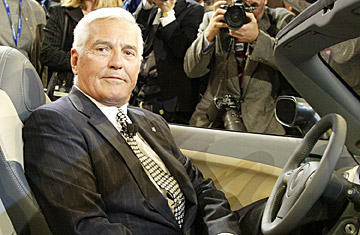
Former vice chairman of the Chrysler Corporation, Bob Lutz
(10 of 11)
DARLA MOORE: You're talking about an entrepreneur now.
GERALDINE LAYBOURNE: The problem with an army of business-school people and, believe me, some of my best friends went to Harvard Business School, but the problem with an army of these very bright people who are trained is that they can find reasons not to do anything.
They can give 55 reasons why something is a bad idea. And, if our business schools don't start training people to find good ideas and nurturing them and encouraging them, we're gonna be in sorry shape.
WALTER ISAACSON: Let me pick two people who never went to business school, sort of entrepreneurs of their time in the aviation industry — Eddie Rickenbacker, the, you know, ace pilot, and Juan Trippe, who went off to war and then—
They both came up with the idea. They were both great entrepreneurs, and they started airlines that then went bankrupt eventually.
GERALDINE LAYBOURNE: Well, they can hardly be blamed for that.
WALTER ISAACSON: Are they— are they— would you put them up there if we had to look at the aviation industry.
ROBERT A. LUTZ: Well, I don't think— I think both of 'em are certainly aviation pioneers and built airlines with arguable success but I think you can't overlook Douglas in that either.
If Henry Ford popularized— or was able to make mass automotive transportation available, I think, Bill Douglas and the Douglas Aircraft Company with the DC-3 brought in the age of mass air travel.
WALTER ISAACSON: And Boeing?
ROBERT A. LUTZ: Yes.
WALTER ISAACSON: Less so.
ROBERT A. LUTZ: later with the 747, and we're seeing at the end of the century the dominance of Boeing, but once again, if you step back from the giant guy today — by the way Boeing and McDonnell Douglas, same company now — but you go back to who started it, who created the revolution, who was it that first mass-produced airplanes that were highly affordable and reliable and could transport people in comfort.
It was— it was Douglas. I just like get— you just did an outstanding job of describing the core of my book and my central theses, which is that—
GERALDINE LAYBOURNE: I knew we'd find something agree—
ROBERT A. LUTZ: Passion and creativity and common sense will beat the MBAs every single time. And I say that having a 3.8 grade-point average from my MBA from a renowned business school. And I couldn't agree more. The business schools create very slick, sophisticated Dr. Nos and bureaucrats who are highly risk-adverse.
So, as we look at lot of these personalities, we do see a lot of mavericks.
WALTER ISAACSON: Let's— on some mavericks—
ROBERT A. LUTZ: Yeah.
WALTER ISAACSON: People who had somewhat quirky ideas that really changed the way we live.
ROBERT A. LUTZ: Absolutely.
WALTER ISAACSON: I'd like to get a few of them on the table 'cause to me they're the most interesting—
NORMAN PEARLSTINE: [crosstalk] Willis Carrier, the notion of air-conditioning. "Hey, we create a sunbelt out it."
GERALDINE LAYBOURNE: But that has increased business productivity probably more than anything that's happened in this century.
WALTER ISAACSON: Sure.
And Clarence Birdseye— the notion— you know, the convenience stuff. Are there any others like these?
RAY BRADY: You know, I'd like to mention a maverick that we passed over, and that was Bill Levitt.
WALTER ISAACSON: Well, he falls in that category. Great idea.
RAY BRADY: Yeah, exactly. That's why I'm bringing him in. And we sort of gave him short shrift, but I was in the service in World War II. So, I know what it was like when it was over.
And there had been no building during the Depression. There had been no building during the way. And you had 12 million GIs coming back, at least half of whom wanted a home and the other half wanted the GI Bill.
And Levitt stepped up, and he took Henry Ford's idea and instead of having the car go to the worker, he had the worker put windows in this house, go here, put windows, windows, a same form of assembly line.
I checked just for the heck of it what those houses went for. They went for $7,990 — $7,990, which was affordable for anybody who'd even been a private in the war and may have been married and had a couple of kids.
And I think that the great transition from wartime to peacetime in this country was aided by Levitt putting up the houses that any GI could afford.
WALTER ISAACSON: Darla, I hate to pick on you on this one 'cause you'll be offended by it.
DARLA MOORE: Oh, oh.
WALTER ISAACSON: Let's talk about illegal empires real quick before we end the show.
DARLA MOORE: Illegal empires?
WALTER ISAACSON: I mean, one of the things we invented in this country this year— I mean, this century — Al Capone, Lucky Luciano, the mob, all that sort of thing.
Do you have a sense of how that played out in our economy? Who should— who should—
DARLA MOORE: Yeah.
WALTER ISAACSON: —reign in that field.
